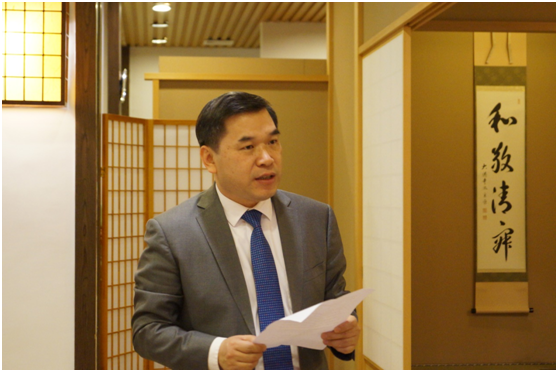On the afternoon of March 9th 2017, a brief exhibition on tea ceremony co-organized by GDUFS and the Consulate General of Japan in Guangzhou was held at the tea house of GDUFS. JIAO Fangtai, Vice President of GDUFS; Mr. Norio Saitou, Japanese Consul General in Guangzhou; Ms. Kyoko Iwama, lecturer of Urasenke (the largest school of traditional Japanese tea ceremony), and other guests of honor were present for the tea ceremony.

Consul General Mr. Saitou delivered a speech
The atmosphere soon warmed up as Consul General Mr. Saitou greeted the attendants in Chinese. And then he switched to his native language: “Tea traced its origin from China and later was brought to Japan, where drinking and serving tea has become an artistic form. Therefore, tea has long served as a bridge of communication between Japan and China. The exhibition today is a great opportunity to introduce and deepen our understanding of the spirits contained in tea culture.”

Vice President JIAO delivered a speech
Vice President JIAO also delivered a brief speech. He pointed out that tea culture is such an inclusive and extensive culture that it has always been valued by our two peoples. Over the past few years, lots of teachers and students have learned to master tea ceremonial skills. “On such a beautiful spring day, it will be a delightful thing to appreciate such an attractive tea ceremony,” he said.

An exhibition of tea ceremony was given by a teacher and two students
And then with a teacher performing as the host, two students the guests, and Ms. Iwama the lecturer, the exhibition of tea ceremony began. Given the time limit, only the main part of traditional tea ceremony was presented, that is, the sea serving part, when small talk between the host and his or her guests takes place.
Japanese tea ceremony is actually not just about drinking and serving tea. The underlying spirits of the ceremony can be intimated from the elaborate preparations and code of conduct during the process. Layout of the tea house will be carefully designed by the host, who wants to serve his or her guests in the best way; tea implements will be deliberately selected in line with the season; sweet confections, which perfectly compliment with the slight bitterness of Matcha (a kind of green tea which is made of dried new tea leaves in spring), will be served. Therefore, we can tell that great importance, during the ceremony, is placed on the interactions between people and people, and people and the environment, and between people and our Mother Nature.

The tea house
The decorative hanging scroll was indeed an eye-catcher with four characters on it: 和敬清寂 (wakeiseijyaku). “Wa” and “Kei” mean harmony and respect respectively, or the harmonious state and mutual respect between hosts and guests and between people and nature; “Sei” and “jyaku” mean purity and tranquility: the tea implements shall be cleaned thoroughly and inner peace of the people involved is required.
The ceremony, traditionally with a duration of four hours, was shortened to an hour due to the time limit, and then the Q & A section followed while the confections were served to the guests. Consul General Mr. Saitou seized the opportunity to raise the first question, “What kind of conversations can be conducted while both the host and the guests are having tea?” Ms. Iwama responded: “Since the whole process is ‘purified’, the topic shall not be associated with practical affairs like marriage, money and promotion.”

The attendants tasted the tea after the exhibition of tea ceremony
The tea ceremony is indeed an artistic form that can help one restore inner peace through its complex and long-standing procedures. It’s said that one can forget about everything but only focus on the tea preparing, which is really a blessing for those who are long trapped by this hustle-and-bustle world, and who, like us students, lose track of traditional culture. When interviewed, Mr. Saitou said that he was very proud to have helped establish the tea house to provide the platform for presenting traditional culture. And he was also satisfied with the hard-won results, seeing that young people can have a taste of harmony, respect, purity and tranquility.
We hope the tea ceremony exhibition can be held smoothly every year to widely disseminate its spirits.

Group photo
